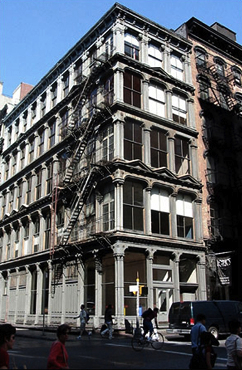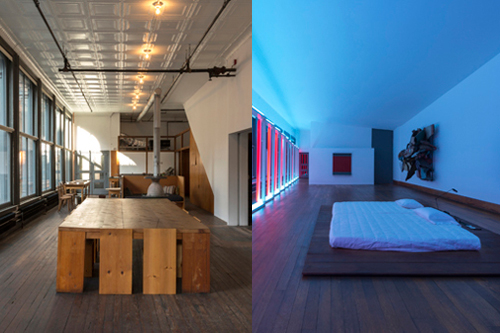Donald Judd (1928-1994) was one of the founders of Minimal art, a movement in which art was stripped down to pure form and proportion, no longer representing anything at all, but simply existing as an elegantly conceived, often geometrically simple object. Judd lived his art, designing geometric furniture and pure living spaces for himself and his family, filtering out all visual clutter. His home, at 101 Spring Street in New York City’s SoHo neighborhood, has undergone renovation and is now open to the public for the first time, a shrine of late 20th century art amid the contemporary retail bustle of the area.

Each floor of the loft is devoted to a specific purpose—the idea was for the residents to change floors when changing tasks. The second floor, for example, was devoted to eating. It contains a simple kitchen with industrial equipment, such as a deli-style meat slicer, and a wooden slab dining table designed by Judd. When serving, nothing was allowed to remain in its original, branded container. Milk would be emptied into a pitcher, and food would be arranged in ceramic bowls. (The only exception to this rule was alcohol. There is a well-stocked liquor shelf in the hallway with its original labeled bottles.) The top floor of the building is for sleeping, with a rectilinear bed placed flat in the middle of the floor, a plane for sleeping, just as the dining table is a plane for eating.
When renovating the building, Judd sought to emphasize its geometry. There are hardly any curves in the entire living space, just clean right angles. Domestic bickering ensued when his wife suggested he buy a sofa, which would have been an intruder in his carefully controlled environment.

Judd’s lifestyle was almost monk-like in its rigorous simplicity. Not many of us would choose to live that way or would even be able to. Like the building at 101 Spring Street itself, we are surrounded by stores, brands, and a clamor of visual and cultural clutter.
Pure geometry exists only in the mind, not in the pitted and worn surfaces we encounter each day. There is a tension between the purity we can imagine and the disjointed urgency of the world around us. But I believe an uninflected visual environment can lead to clarity of thought. Minimalism is not so esoteric a concept that it cannot be reflected in our everyday lives, even in such things as well-organized shelves and a neat desk. The less one sees, the more carefully it can be considered. Organization and simplicity can provide a refreshing mental purge to reach a creative blankness, a tabula rasa from which to proceed. Many religious traditions describe a kind of cultural retreat: Jesus meditating and fasting for 40 days in the desert, for example. A desert is an uninflected visual environment par excellence, an emptiness in which thoughts can turn inward toward their thinker.

Accessible deserts for meditation are not an option for many of us, though, and I know we’ve all seen too many articles admonishing us to “de-clutter your life.” I don’t believe a total renunciation of clutter is necessary, but we should attempt an occasional respite. A meditation I’ve done for years is to shut my eyes and imagine a pure white field. This takes effort to produce and even more effort to maintain. Looking out into open water is another option for clarity if one is lucky enough to live close to it. One can always look up at the sky, not necessarily at its most dramatic sunset moments but into an uninflected field of blue or gray that provides a counterpoint to our strivings and struggles below.
Consider a metaphor from the world of art: a picture framed with a cardboard mat. The mat enhances the art by providing a buffer between it and the visual clutter that surrounds it—a useful blankness. To me, the art and home of Donald Judd is like that mat: minimal, geometric, and valuable as a way of increasing our visual perception.
For more information about the Donald Judd residence or to plan a guided visit, see the Judd Foundation’s website.




1 Comment
Pamela
Extremely cool. Thanks for writing about this. Great to see that it’s open to the public.